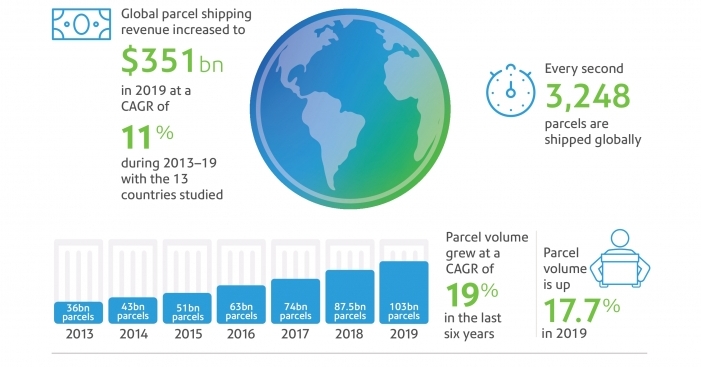First time ever, global parcel volume exceeds 100 bn in 2019
October 14, 2020: Pitney Bowes, a global technology company that provides commerce solutions in the areas of e-commerce, shipping, mailing, data and financial services, on Tuesday released the annual Pitney Bowes Parcel Shipping Index, reporting that global parcel volume surpassed 100 billion, for the first time ever, in 2019, reaching 103 billion,

October 14, 2020: Pitney Bowes, a global technology company that provides commerce solutions in the areas of e-commerce, shipping, mailing, data and financial services, on Tuesday released the annual Pitney Bowes Parcel Shipping Index, reporting that global parcel volume surpassed 100 billion, for the first time ever, in 2019, reaching 103 billion, with 17.7 percent growth.
More than three of every five parcels shipped in the world’s major markets are generated by China. Over 3000 parcels were shipped every second in 2019 in the world’s 13 major markets. The report forecasts parcel volume is most likely to more than double and reach 220-262 billion parcels by 2026, with a 14.8 percent CAGR for 2020-2024. Due to the uncertainty in the market fueled by the global pandemic, the forecast provides a range that shows volumes could be as low as 200 billion or as high as 316 billion parcels in six years.
On average, 3,248 parcels were shipped every second in 2019 in the world’s 13 major markets, equating to an average of 27 parcels shipped per person. China remains the strongest influence on the market with 63.5 billion parcels shipped in 2019 and an increase of 26 percent in parcel volume year-over-year.
Jason Dies, EVP and Vice President Sending Technology Solutions, Pitney Bowes, said, “As we mark Pitney Bowes’ 100th anniversary, this year’s milestone of global parcel volume surpassing 100 billion parcels seems particularly serendipitous. While parcel volumes keep rising, carriers are racing to keep up with competition and with consumer demand, delivering innovative new customer experiences, digitalizing technologies and investing in infrastructure, all while generating sustainable revenues. Our Index has a track record of accurate forecasting, and our adjusted forecasts of parcel volume reaching 220 – 262 billion by 2026 demonstrate the phenomenal growth expected across the industry”.
Findings for Asia Pacific
- Australia shipped 934 million parcels, an increase of 8 percent year over year
- China’s parcel volume reached 63.5 billion in 2019, up from 51 billion in 2018 and 40 billion in 2017
- India’s parcel volumes have increased steadily since 2013 to 2.8 billion, with a CAGR since 2013 of 22 percent – one of the highest rates of volume growth in the Index.
- Japan’s parcel volume, 9 billion, declined by 3 percent from the previous year. Revenue increased by 5 percent to $31.5 billion.
India
India has the third highest percentage increase after China and Norway, experiencing growth of 19 percent in parcel volume, shipping 2.8 billion parcels and reaching a CAGR of 22 percent since 2013.
Since the outbreak of the Covid-19 pandemic and complete lockdown during March till May 2020, the Indian e-commerce and parcel delivery sectors were severely hit as the government allowed e-commerce companies to fulfill only essential orders such as groceries, medicines etc. In mid of May, the Indian government allowed the e-commerce firms to resume full operations, which led to a surge in volume. We expect to see these volumes reflected in next year’s index.
The report highlights that the Indian parcel volume is growing significantly and has reached 3 billion, experiencing YoY growth of 19 percent. Indian e-commerce sector is growing significantly and has witnessed a growth rate of 31.9 percent in 2019 to reach $42 billion. This growth is majorly fueled by the increased penetration of smartphones and internet services in Tier 2 and 3 cities, introduction of cash-on-delivery, easy return policies, and faster delivery options. Retailers like Amazon, Alibaba, Walmart and international carriers like DHL, FedEx are expanding their operations and investing in innovations to meet the growing parcel deliveries.
Amazon Transportation parcel volume delivery grew by 54.5 percent YoY in 2019 and replaced BlueDart as the second largest carrier in 2019. Recently, Amazon announced that it is planning to add five new sortation centers and expand the existing eight sortation centers in the country. With this expansion the company aims to strengthen its delivery speed and connectivity of customers & sellers. In January 2020, Amazon India announced its plan to deploy 10k EVs (electronic vehicles) by 2025, as an integral milestone to become an energy efficient courier.
Indian carriers are also investing significantly to expand their transportation network. Last year, Ekart, the logistics arm of e-commerce giant, Flipkart, announced to replace nearly 40 percent of its last-mile delivery fleet with EVs. The company is working with local partners to co-design EVs best suited for the growing e-commerce industry. Flipkart had announced its minority investment in Shadowfax (India-based on-demand logistics network provider), to enhance the former’s local delivery capability alongside reducing delivery time and enhancing customer experience.
Paytm Mall on the other hand is said to be planning to launch a single-day delivery pilot with its existing delivery partners and Gati. Delhivery announced investment up to ₹3 billion to expand its trucking infrastructure such as increasing fleet size and setting up trucking hubs in the next 2 years.



